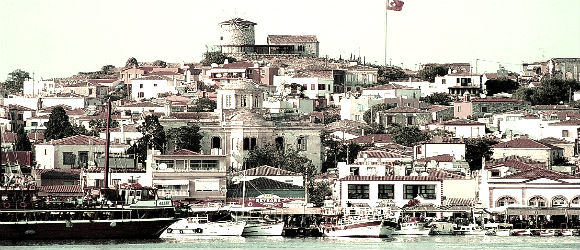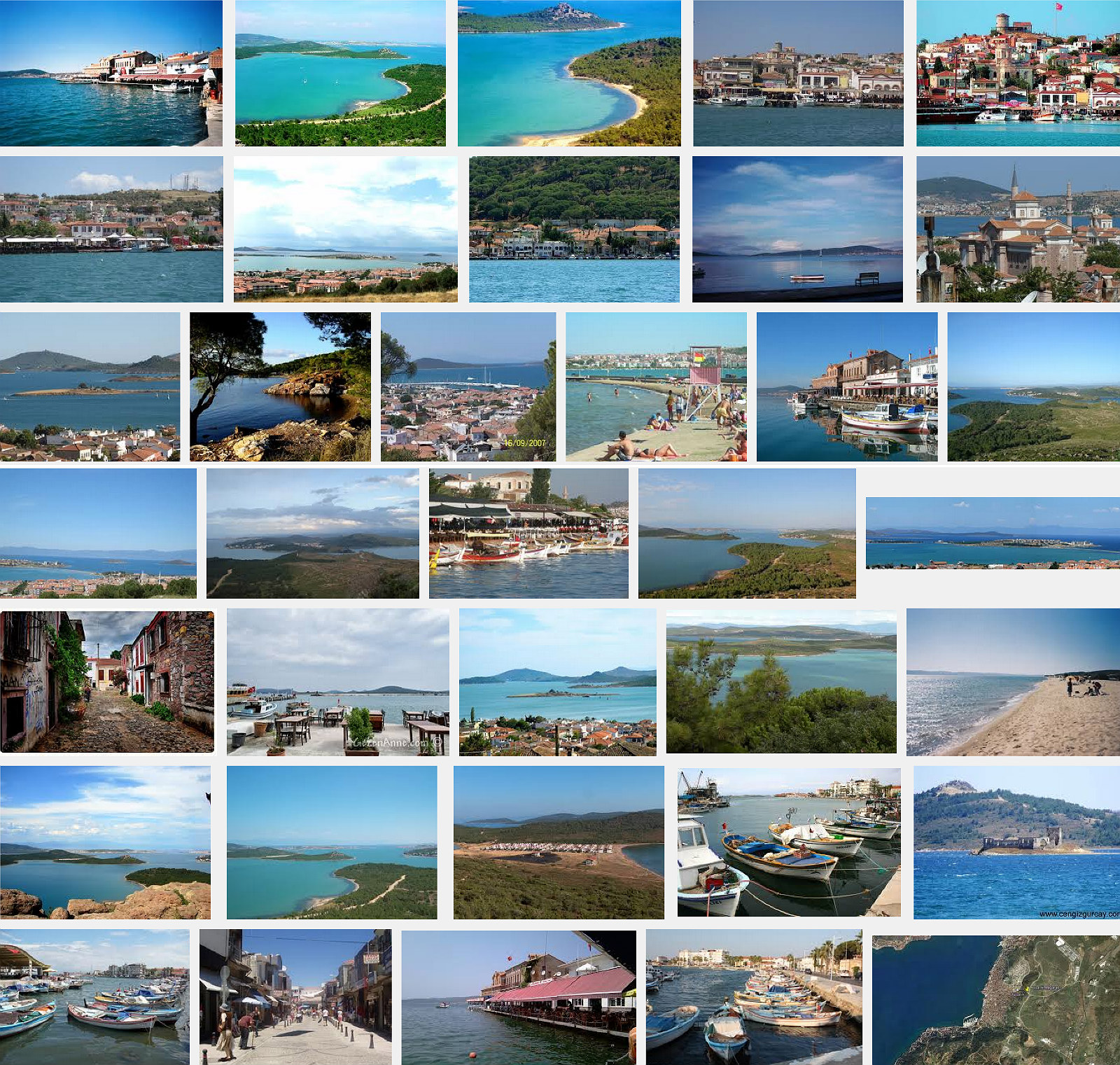As you might imagine from a glance at the surrounding countryside, the cultivation of olives is important to this region. Actually, the Aegean coast was heavily populated by Greeks during the Ottoman Empire’s time, and these communities controlled a big part of the olive commerce. After the exchange of populations, Turkish settlers took over the industry in Ayvalik. Today the olive oil from this region is known all over Turkey.
The town itself stretches for several kilometers along the waterfront, and there are smaller “suburbs” on nearby islands and peninsulas.
Besides its olive and olive oil produce, Ayvalık is also known as a fine, restful little resort town where city people come for a week or two in the summer, rent a room in a hotel or in one of the town’s many old mansions (now pensions), and swim, spend hours over dinner, take a boat tour, or find a disco in the evening.
GETTİNG THERE: Unless you are careful to catch a bus that goes specifically to Ayvalık’s Otogar, your bus will drop you at the northern turnoff for Ayvalık and you’ll be three miles from the main square you’ll have to hitch a ride into town. If you’ve been careful to get a bus that goes into Ayvalık, you will descend at the Şehirlerarası Otobüs Garajı, exactly a mile north of the square. You can catch any municipal bus (“Ayvalık Belediyesi”) going south past the bus station, or you can hoof it. The walk downtown to the main square takes only 15 or 20 minutes.
ORIENTATION: The better part of the town is clustered around this square and up the slopes of the hill curving up from the water. The main street goes south along the coast past sections called Orta Çamlık and Çamlık, where many of the better hotels and pension choices are, and then past two or three discotheques and on to Sarımsaklı Beach, a few kilometers from the town. Ayvalık’s plush motels are on this beach, as are some more modest hostelries and some restaurants. The Tourism Information Office (tel. 6631/2122) is less than a mile south of the main square opposite the yacht harbor.
HOTELS: Those used to staying in comfort have their choice of two attractive beachfront hotels on Sarımsaklı Beach, or another in a quiet, shady hideaway on another shore. The hotels right in Ayvalık are mostly very plain, but also clean and cheap.
Downtown Hotels; Low-budget travelers will be delighted with the selection of plain but clean hostelries right near the main square. Though they are not on the beach, and do not usually have such luxuries as private bathrooms, they are certainly at the center of the action. Getting to the beach is cheap and easy by municipal bus.
RESTAURANTS: Those staying at one of the better hotels may have the meal question answered by a full-board requirement. If not, the first place to try is Ali Bey Island (see below). After that, there are several little places in the center of Ayvalık
Seafood is the specialty.
WHAT TO SEE AND DO: Water sports and seafood dining are Ayvalık’s forte but before putting on your bathing suit or your napkin, take a stroll around this little town.
A Walk Around Ayvalık; The big olive-oil processing factories are right near the waterfront, but if you go back into the town you’ll see some pretty streets of old classical-style architecture (another hint of the empire times). Walk on the street just out of the main square on which you find the Canlı Balık restaurant, and after a few blocks you pass the Çınarlı Mosque, an Orthodox church converted into a mosque. The iconostasis (the wall between the congregation and priests) is all in bright-blue, white, and gold; all of the pictures of saints have been removed in keeping with the Muslim ban on representation of the human form, and a Muslim pulpit has been made out of the original one. Remember to take your shoes
off before entering.
Look for another minaret near the one on this mosque and you’ll see another place of worship with the same history. Also, walking along the winding streets you pass carpenters’ shops, bakeries, children tending goats, and shady little squares, always with a few tables and chairs for customers of a nearby tea house.
Harbor Tours; Right off the main square, boats load up each morning, afternoon, and evening for tours among the dozens of little islands and many peninsulas which make this coastline so interesting.
Beaches; Besides the little beaches on Ah- Bey Island (see below) and at Çamlık, Sarmisakli Beach, reached from the town square by bus or dolmush, offers you almost 12 km of sand and sun. Some of this is taken up by private establishments, some more has been claimed by little huts thrown up just for the summer. If you walk in the direction of Lesbos toward the tip of the peninsula, you’ll find deserted stretches of beach. The really private areas are all the way around on the far side of the peninsula. If you’re willing to walk you can have a whole beach to yourself.
Şeytan Sofrasi; Overlooking the beach, in fact the whole area and all the way out to Lesbos, is the hilltop called Şeytan Sofrası, the Devil’s Dinner Table. A side road off the main road near Sarmisakli leads to the top, and it takes about a half hour to walk. In the late afternoon or evening take a cab from the main town square for the trip to the top, where there’s a snackbar.
An Excursion to Ali Bey Island; Across the water from the main part of town, on what is technically a peninsula, though it’s called an island, is a settlement called Ali Bey Island, or Cunda. You can get there by taxi, but the cheapest way (and more fun) is to take one of the motor launches that plies back and forth between the dock near the town square and the island. Boats leave on the hour from 7 in the morning until 11 in the evening (there’s a full schedule posted by the dock) for the 20-minute ride, one way. If you walk to your right as you come off the wharf you pass a row of small outdoor fish restaurants right on the water, took an early-evening boat to the island with two friends and we picked out one of these places a difficult task, since they’re almost identical named, oddly enough, the Canlı Balık (“The Live Fish”). You might be able to tell it by the fish net and floats hung over the eating area. We had a table right on the water, and a friendly waiter brought us, in the course of the evening, four plates of fish, one plate of eggplant paste (patlıcan ezmesi) made with garlic and spices to eat on bread, one plate of barbunye (large flat beans in oil), two plates of patates köfte (light, soft cylinders of whipped potato rolled in crumbs and browned in a frying pan), two salads, one plate of sliced eggplant with yogurt, bread, and three full bottles of a local red wine (quite drinkable).
The town has a sleepy, stow quality and is obviously too big to be filled by its present number of citizens. It’s an old settlement the streets have a medieval, built-in central gutter with some charming old houses and a large, now-unused Orthodox church. Across the water from the town is another island, with the ruins of a monastery on it, and in between the two islands, the boats between Greece and Turkey thread their way through a narrow channel marked by rows of buoys.
LEAVING AYVALIK: Most visitors who come through Ayvalık are on their way south to Bergama and İzmir. But Ayvalık also has direct ferry connections with the Greek island of Lesbos (Mytileni).
Boats to Lesbos; Every day from late May or early June through September, boats (both Greek and Turkish) carry passengers between Ayvalık and Mytileni. Leave from Ayvalık any weekday at 9 a.m. on the Turkish boat, or at 5 p.m. on the Greek boat. On Saturday departures are at 5:30 a.m., on Sunday at 6 p.m. At other times of year there may be one or two boats a week. In bad weather, and in the winter, there may be no boats at all.
A number of small agencies near Ayvalık’s main square sell tickets for these boats. Look in the streets near Gümrük Meydanı.
Ayvalik is absolutely fabulous-great places to retire in Turkey
Great Places to Retire in Turkey, Ayvalik,


